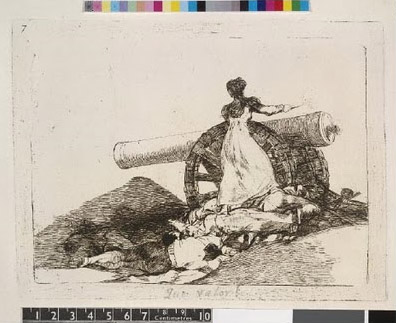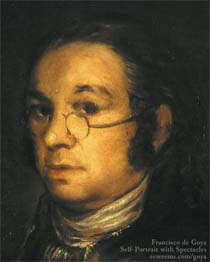
Artist Gary Arseneau Decries 'forged' Goya etchings

[Image from Arseneau's article on the 'forged' Goya prints]
Gary Arseneau attacks the National Gallery of Canada's Goya show for using the late edition plates from Goya's Disasters of War series printed well after Goya's death. In a fairly succinct critique, Arsenau explains the chronology of Goya's work with the Los Desastres de la Guerra series, comparing the National Gallery set now on display against the rare 1810 edition that Goya gave to his friend Cean Bermudez. Arseneau then attacks the etching printings of 1863 onward (which are the versions available in most Goya books and presented at museum shows. These are a slightly truncated set of 80 images from the the complete run of 83 known, not counting the rejected plate "infamous advantage" which Goya apparently dropped from the series, though reusing some elements in plate #22.) Arseneau also specifically attacks the ethics and the lack of explanation from the National Gallery of Canada for not pointing out that what they are presenting is not a true version of Goya's work.
Well worth reading. The argument could apply to many works of art that exist in private and public collections: original pieces that were changed or modified after the author no longer had contact or control over the piece. In particular, Goya's Black Paintings are known to have been retouched a number of times for the sake of preservation, but historical records indicates some of the retouching went much further and actually altered some images.
Francisco de Goya y Lucientes
Born March 30, 1746 – Died April 16, 1828. Spanish painter applauded in art history as the transition personality between the Old Masters and modern art. Court painter to the Spanish Crown, Goya pursued personal projects in paint, drawings and etchings in which he chronicled national historical events and carefully articulated a critique of Spanish, and then European ideals, society, morales and religious institutions.-
GOYA TOP PICKS:
-
Saturn (Painting)
-
The Black Paintings
-
Goya Art Index
-
Goya Biography
-
3rd of May (Painting)
-
Sleep of Reason (Caprichos #43)
Goya Ephemera
"From this headlong seizure of life we should not expect a calm and refined art, nor a reflective one. Yet Goya was more than a Nietzschean egoist riding roughshod over the world to assert his supermanhood. He was receptive to all shades of feeling, and it was his extreme sensitivity as well as his muscular temerity that actuated his assaults on the outrageous society of Spain." From Thomas Craven's essay on Goya from MEN OF ART (1931).
"...Loneliness has its limits, for Goya was not a prophet but a painter. If he had not been a painter his attitude to life would have found expression only in preaching or suicide." From Andre Malroux's essay in SATURN: AN ESSAY ON GOYA (1957).
"Goya is always a great artist, often a frightening one...light and shade play upon atrocious horrors." From Charles Baudelaire's essay on Goya from CURIOSITES ESTRANGERS (1842).
"[An] extraordinary mingling of hatred and compassion, despair and sardonic humour, realism and fantasy." From the foreword by Aldous Huxley to THE COMPLETE ETCHINGS OF GOYA (1962).
"His analysis in paint, chalk and ink of mass disaster and human frailty pointed to someone obsessed with the chaos of existence..." From the book on Goya by Sarah Symmons (1998).
"I cannot forgive you for admiring Goya...I find nothing in the least pleasing about his paintings or his etchings..." From a letter to (spanish) Duchess Colonna from the French writer Prosper Merimee (1869).
